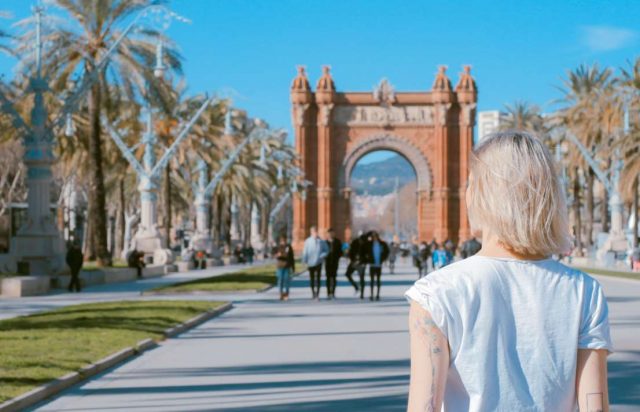While it is worldwide known as “The Magic Fountain”, its complete name is Montjuïc Magic Fountain (or Font magical de Montjuïc in its original language), and it is located in Carles Buïgas Square, between the Plaça d’ Espanya and the Museu Nacional d’Art de Catalunya, in the Sants-Montjuïc district. While its beauty is notorious at any time of any day, many tourists choose to catch a view of its renowned shows. Here, we propose a guide through the history of this tradition.
Origins of the Fountain
Built-in 1929 by Carles Buigas on the very site Cadafalch’s Four Columns had stood until 1928, the project was presented as the “special touch” that the International Expo being held needed. Though many questioned the amount of time required to make the ambitious plan come true, it took a year and 3,000 workers, but they provided what was asked. Since its foundation, it has been repaired several times and came to include technology such as 3D generators or replacing the old illuminating system for one with RGB LED technology without losing many of its original mechanisms. This last change and the choice to use groundwater are steps towards sustainability.
The shows
The now traditional shows began on May 19th of the same year of its inauguration, during the Exhibition. They have been present throughout some of Spain’s most notorious days, such as the 1992 Olympic Games (on this occasion, the fountains were totally restored), the Piromusical de La Mercè, the MTV Europe Music Awards, and many other concerts and events. Recently, it has become a part of the New Year’s Eve tradition of the Twelve Grapes (which go with twelve clock bell strikes), in which are the last stop of the “twelve volcanos” that erupt with each bell strike. Nowadays, they are a part of Barcelona’s culture tour, whether you are a local, a tourist, or someone learning the culture and doing a spanish language course barcelona. The performances depict a combination of music (which was added in the 80s) and light mixed with dancing water flows. Though the show days vary according to the seasons, they are usually held at night, between 8 and 9 pm. As the Fountain is separated into three pools, the amount of water can go up to 2,600 liters per second, making it the most significant water volume in a fountain in the city. The pressure at which the water is displayed goes along with the music and the lights, which can turn into five colors (red, blue, green, yellow, and white) through particular prisms and sealed-with-glass concrete skylights. The control center regulates the whole choreography. Through this system, it can create up to 7 billion combinations. (1)
Other activities that you can try in Barcelona
As previously stated, The Magic Fountain is only one stop of the cultural tour you can try in Barcelona. Some of its landmarks are:
- Casa Milà (also known for those doing a spanish language course Barcelona, as La Pedrera): another of Gaudi’s works, it gained its nickname due to the purpose of the initial project, which was an apartment building. Nowadays, it provides the perfect environment for art exhibitions and cultural events. It is near Casa Batlló, yet another architectural icon with Gaudi’s signature. Casa Milà’s wavy and clear-colored design contrast with Casa Batlló’s shiny, iridescent, dragon-like structure, sprinkled with balconies that resemble bones.
- The Sagrada Familia: the most notorious amongst Gaudi’s works and one of the most infamous buildings in Barcelona, this church was named a World Heritage Site by UNESCO. Though both its size and design are impressive, the story that surrounds it does not fall short of its beauty, for its construction was never completed, and it is, in fact, still in progress (after more than a hundred years since the beginning of the process, it is estimated to be finished in 2026). Its towers (Passion façade and Nativity façade) are open to visitors, but tourists must consider that its tour is highly demanded.
- La Rambla: though it is not just one building, it is a must-see spot in the city. It runs from the plaça de Catalunya to the Christopher Columbus Monument in Port Vell, and its origins trace back to the tenth century when it was used as a waterway. Here, you will find both the oldest running theater in the city (the Great Theatre of the Lyceum) and the oldest (though not currently active) theater in Barcelona (the Teatre Principal), among some other notorious examples, such as The Virreina Palace, the Arts Santa Mònica, the Museu De L’Erotica Barcelona, the Güell Palace (in which you will find the mosaic lizard that is the subject of many of the city iconic images immersed in a tiled garden filled with sculptures) and the Bone Square (also known as Pla de l’Os, a mosaic in the pavement created by Miro). You can also grab a bite at The Boqueria, a traditional market since medieval times.
- Museu Picasso: it is hard not to link Picasso with Barcelona. Though this museum does not guard some of its most notorious works (Guernica or The Weeping Women), its collection goes up to 4000 pieces, in which visitors can see the evolution of the painter’s creative conceptions.
- The Gothic Quarter: its narrow streets do not diminish its cultural impact, for this area (also named Barri Gòtic) is famous because of the sites it connects. You can wander around its secret squares and historical buildings and visit Plaça del Rei, Plaça Sant Jaume, and even one of the city’s most notable churches, the Barcelona Cathedral, a gothic-styled-landmark since its foundation in 1298. It was built on the terrain that held what used to be a Roman temple thousands of years ago, and it has been repaired and completed with new ornaments since its origins.
Barcelona is known worldwide for its culture, beauty, and architectural jewels, and it is growing bigger and buzzier by the day. Whether you are a local, a tourist, or a foreigner looking to settle in the city, you will always have sites to visit. (2)

Speaks from heart, always too passionate and driven by emotions. Spins the words with kindness & sharpness, intriguing your ever-inscrutable minds.





